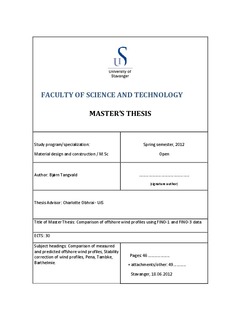| dc.description.abstract | The use of wind energy for power purposes has a long history going back to the medieval times. In recent times the wind energy has experienced a great development in both size and the energy output it can produce. Previously use of wind turbines was constricted to land only, but because of the increasing need for reliable and also the wish for cleaner energy, wind turbines are now being placed in offshore environments.
The theories being used to understand the wind forces and conditions are the same as used for onshore applications, however recent research concludes that this assumption is not always correct. One of the areas where this simplification has shown to be incorrect is in the structure of the atmospheric boundary layer, and the height of the surface layer, which can be problematic since this is the areas where the wind turbines are operating. In order to get a better and more correct understanding of the actual conditions new methods must be derived. This thesis looks at offshore wind profile that will be appropriate for wind turbines located at sea. The thesis has focused on comparing theoretically calculated wind profiles with actual wind speed measurements (FINO-1 and FINO-3), and further tried to describe and display the accuracy of the different methods. Also a theoretical basis is given to understand the driving forces behind the wind profiles. The methods used here are gathered from relevant standards (DNV and Germanischer Lloyds) and a few more recent methods derived from research, which are supposed to give more accurate description of the offshore wind profiles (Barthelmie 2010, Pena 2008 and Tambke 2005). Due to lack of high resolution data the Barthelmie method could not be calculate. There were also problems recreating the Tambke method as it was described in the paper tambke et al.(2005), no results are therefore given from this method. The results presented in section 5 clearly show that including stability corrections when calculating the wind profiles, give much better plots and RMSE results. Another parameter that greatly affects the wind profile is the roughness length. Standards normally recommend ranges for this parameter, but often a constant value within this range is chosen when calculating the wind profile. Results show that this parameter varies significantly and that the assumption of a constant value is wrong, the roughness length should therefore be calculated for each case since this gives the best results. The results showed that the Pena method gave most accurate predictions, which was as expected because it accounts for stability corrections and the boundary layer height. The logarithmic method with stability corrections also gave good result, but in stable conditions over corrects giving too high values of wind shear. | no_NO |
